After the Battle of Midway, the United States launched a counter-offensive strike known as "island-hopping," establishing a line of overlapping island bases, as well as air control. The idea was to capture certain key islands, one after another, until Japan came within range of American bombers. Led by General Douglas MacArthur, Commander of the Allied forces in the Southwest Pacific, and Admiral Chester W. Nimitz, Commander-in-Chief of the Pacific Fleet, the first stage of the offensive began with the Navy under Nimitz, and Marine landings on Guadalcanal and nearby islands in the Solomons.
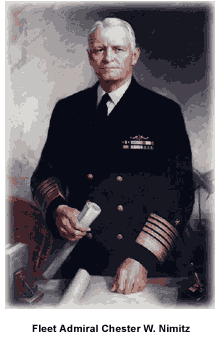 From that point on, Nimitz and MacArthur engaged in "island-hopping" amphibious drives that bypassed strongly-held islands to strike at the enemy's weak points. In an effort to liberate the people of the Philippine Islands, MacArthur pushed along the New Guinea coast with Australian allies, while Nimitz crossed the central Pacific by way of the Gilberts, Marshalls, Marianas, Carolines, and Palaus. Both campaigns would entail seemingly endless, bloody battles — ultimately leading to the unconditional surrender of the Japanese.
Preparing for U.S. counterattack
Admiral William "Bull" Halsey, commander of the U.S. Third Fleet, flew to MacArthur's headquarters in Brisbane, Australia, where they discussed campaign strategy. MacArthur's headquarters issued plans on April 26th that laid out a two-pronged offensive, code-named CARTWHEEL, which would corner the Japanese at Rabaul Island. One prong — MacArthur — would advance along the northern shores of New Guinea and into the Bismarck Archipelago. The second prong — Halsey — would drive northwest from Guadalcanal and control the remainder of the Solomon Islands.
Buna
By November 1942 the Japanese had established a jungle fortress around Buna and Gona. Inexperienced with guerilla warfare, weather-beaten, sick, and short on artillery and rations, the Australians and Americans could not dislodge the dug-in Japanese. General MacArthur sent Lt. General Robert Eichelberger to lead the Buna campaign.
On December 9, 1942, the Allies stormed Gona and captured it during the last week of January 1943. MacArthur then turned his attention to the key Japanese airfield at Lae and control of the coastline facing New Britain. After a series of land and sea attacks, the Allies landed in New Britain at the end of 1943.
Solomon Islands
Guadalcanal
To make the first Buna Allied offensive in the Pacific more effective, the Americans readied a separate attack from a different direction. That decision brought American forces into the Solomon Islands and U.S. Army infantry onto the island of Guadalcanal.
From that point on, Nimitz and MacArthur engaged in "island-hopping" amphibious drives that bypassed strongly-held islands to strike at the enemy's weak points. In an effort to liberate the people of the Philippine Islands, MacArthur pushed along the New Guinea coast with Australian allies, while Nimitz crossed the central Pacific by way of the Gilberts, Marshalls, Marianas, Carolines, and Palaus. Both campaigns would entail seemingly endless, bloody battles — ultimately leading to the unconditional surrender of the Japanese.
Preparing for U.S. counterattack
Admiral William "Bull" Halsey, commander of the U.S. Third Fleet, flew to MacArthur's headquarters in Brisbane, Australia, where they discussed campaign strategy. MacArthur's headquarters issued plans on April 26th that laid out a two-pronged offensive, code-named CARTWHEEL, which would corner the Japanese at Rabaul Island. One prong — MacArthur — would advance along the northern shores of New Guinea and into the Bismarck Archipelago. The second prong — Halsey — would drive northwest from Guadalcanal and control the remainder of the Solomon Islands.
Buna
By November 1942 the Japanese had established a jungle fortress around Buna and Gona. Inexperienced with guerilla warfare, weather-beaten, sick, and short on artillery and rations, the Australians and Americans could not dislodge the dug-in Japanese. General MacArthur sent Lt. General Robert Eichelberger to lead the Buna campaign.
On December 9, 1942, the Allies stormed Gona and captured it during the last week of January 1943. MacArthur then turned his attention to the key Japanese airfield at Lae and control of the coastline facing New Britain. After a series of land and sea attacks, the Allies landed in New Britain at the end of 1943.
Solomon Islands
Guadalcanal
To make the first Buna Allied offensive in the Pacific more effective, the Americans readied a separate attack from a different direction. That decision brought American forces into the Solomon Islands and U.S. Army infantry onto the island of Guadalcanal.
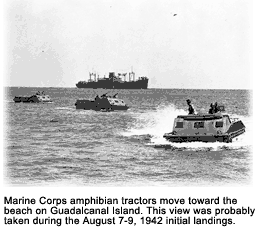 On the morning of August 7th, 1942, the First Marine Division followed heavy naval preparatory shelling, and landed on the north beaches east of the Tenaru River. In a three-month struggle marked by disease (diarrhea, malaria, dysentery, skin fungus), and many casualties, the marines took an airfield and established a beachhead roughly six miles wide and three miles deep.
During the last weeks of 1942 and the first weeks of 1943, the Americans strengthened their foothold on Guadalcanal by reorganizing and bringing in fresh troops, the Second Marine Division and the 25th Infantry Division. The Japanese held off five American battalions for a month, which delayed the advance west long enough for the defenders to evacuate 13,000 men from the island. Allied forces quickly constructed landing strips — the first series of island hopping had begun.
New Georgia
Admiral Halsey landed troops on New Georgia, while MacArthur's troops moved to Nassau Bay, New Guinea.
The New Georgia offensive, code-named TOENAILS, was a learning experience for Allied forces in the region. Shallow reefs surrounded those islands, making it difficult to navigate large watercraft through narrow rock channels. Also, Japanese soldiers in pillboxes, and deeply dug in, were nasty obstacles to overcome during the New Georgia Campaign.
Heavy rains reduced visibility almost completely, and high winds and rough seas wreaked havoc with the landing operation. Amphibious vehicles had to follow the sound of breaking waves to find the shore. In the ensuing chaos, six landing craft became lodged on the coral reef, while others discharged troops at the wrong site and then had to reload. Over the next four days, marines and Solomon Island soldiers, supported by 105-mm howitzers from the 152d Field Artillery Battalion, rooted out the Japanese from Wickham Anchorage.
On the morning of August 7th, 1942, the First Marine Division followed heavy naval preparatory shelling, and landed on the north beaches east of the Tenaru River. In a three-month struggle marked by disease (diarrhea, malaria, dysentery, skin fungus), and many casualties, the marines took an airfield and established a beachhead roughly six miles wide and three miles deep.
During the last weeks of 1942 and the first weeks of 1943, the Americans strengthened their foothold on Guadalcanal by reorganizing and bringing in fresh troops, the Second Marine Division and the 25th Infantry Division. The Japanese held off five American battalions for a month, which delayed the advance west long enough for the defenders to evacuate 13,000 men from the island. Allied forces quickly constructed landing strips — the first series of island hopping had begun.
New Georgia
Admiral Halsey landed troops on New Georgia, while MacArthur's troops moved to Nassau Bay, New Guinea.
The New Georgia offensive, code-named TOENAILS, was a learning experience for Allied forces in the region. Shallow reefs surrounded those islands, making it difficult to navigate large watercraft through narrow rock channels. Also, Japanese soldiers in pillboxes, and deeply dug in, were nasty obstacles to overcome during the New Georgia Campaign.
Heavy rains reduced visibility almost completely, and high winds and rough seas wreaked havoc with the landing operation. Amphibious vehicles had to follow the sound of breaking waves to find the shore. In the ensuing chaos, six landing craft became lodged on the coral reef, while others discharged troops at the wrong site and then had to reload. Over the next four days, marines and Solomon Island soldiers, supported by 105-mm howitzers from the 152d Field Artillery Battalion, rooted out the Japanese from Wickham Anchorage.
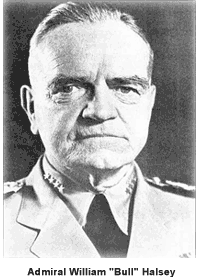 On August 5th, 1943, the capture of Munda airfield was assured, giving the Allies a huge vantage point. However, it was only one phase of the New Georgia campaign. Japanese were still on New Georgia, as well as on other surrounding islands. Those islands had to be taken or neutralized before the Americans could continue island-hopping up the Solomons chain.
While firing their remaining artillery, Japanese forces desperately attacked through the ravines and gullies of northern New Georgia. A pounding barrage of counter mortar fire by the 129th mounted tank-infantry rained down on the the Japanese, devastating them in front of the American line. After suffering terribly (more than 5,000 killed), the remaining Japanese troops left behind their wounded and retreated off the island. With the highest number of non-combatant U.S. casualties (jungle disease) in the island-hopping campaign, the New Georgia mission became a costly success.
The next few weeks brought sporadic fighting as XIV Corps pursued the beaten Japanese. During those operations the First Battalion, 24th Infantry Regiment, became the first black American infantry unit to engage in combat during the war. The 25th Regimental Combat Team of the 93d Division also joined in the final operations of CARTWHEEL.
Bougainville
On November 1, 1943, the Allies attacked, going ashore at Empress Augusta Bay. The 60,000 elite Japanese troops, concentrated in the southern half of the island, did not want a repeat of Guadalcanal. Although the western part of Bougainville was left relatively undefended by the Japanese, the Allies concentrated on attacking from the sea and the sky.
The Japanese responded with naval and air vessels from Rabaul, but were pummeled and sustained heavy casualties. Four days later, on November 5th, Admiral Halsey dispatched a carrier air strike against Rabaul, thus knocking down many Japanese planes and forcing the naval forces to flee to the open ocean. The battle for Bougainville proved to be the site of some of the fiercest battles during World War II.
In November 1944, command of all island operations passed from General Griswold to Lt. Gen. Sir Stanley Savige of the Australian Army, and by mid-December Australian forces had relieved all American units.
In the Solomons, most of the Japanese soldiers who escaped fought again another day.
Gilbert Islands
Near the close of 1943, a thrust at the Gilbert Islands from the Central Pacific, in which Tarawa, Makin, and Apamama were seized, paved the way for the assault on the Marshall Islands on January 31, 1944.
Previous raids by bombers of a U.S. Navy task force had brought the Gilberts under fire in January 1942. The following August, "devil dogs" (marines) spent an active night there demolishing installations and most of the small Japanese barracks.
Landings at Makin and Tarawa, 105 miles away, were planned to begin simultaneously by two separate landing forces from Task Force 54, Rear Admiral Richmond K. Turner commanding. A complement of six fleet carriers, five light carriers, six battleships, six cruisers, and 21 destroyers were deployed; 7,000 troops of the 27th Infantry Division also were deployed. At 8:30 a.m., November 20th, 1943, the first landing craft were to touch the beach at each atoll*.
While the 27th Division Landing Team, with attached units, took Makin on the 20th of November, the Second Marine Division was to assault Tarawa, leaving one of its combat teams in reserve for the support of one or both operations. If that reserve remained uncommitted, it was later to occupy Apamama. LVTs (Landing Vehicle, Tracked), popularly called "alligators," were ordered to move at once to the flanks and there establish positions defending the beaches.
After four days of relatively low resistance, Makin was secured. However, Tarawa was a different story. Betio, the primary island of Tarawa atoll, is only two miles long and 600 yards wide, but it had the only airstrip in the islands and was vigorously defended by highly trained Japanese troops.
Machine gun positions, concrete bunkers and pillboxes (Japanese foxholes), mines, and eight-inch coastal gun emplacements, told a story of formidable Japanese defenses. Admiral Keiji Shibasaki (Japanese commander on Betio) boasted that a million men could not take Tarawa in a hundred years. Shibaski soon realized his under-estimation of Allied capabilities — mostly by way of America's relatively new invention, the flame thrower.
Banzai! After two hours of heavy bombing, and before dawn on November 20th, 1943, the first wave of marines stormed the Tarawa atoll. "Bloody Tarawa," as it soon was known, required 76 hours before a final "Banzai" (suicide) rush of the Japanese signaled the end. While the Americans inched inland, the 4,500 Japanese defiant defenders were slowly crushed. Only 17 Japanese troops, of the original 4,500, made it out alive. One thousand of the 5,600 Americans that rushed the beaches of Tarawa gave their lives — 3,000 of them were wounded.
MacArthur pushes for the Philippines
Meanwhile, American forces in the Southwest Pacific were approaching Mindanao, southernmost of the Philippine Islands, by advances through New Guinea in which Japanese armies were neutralized and isolated on New Ireland and New Britain.
On August 5th, 1943, the capture of Munda airfield was assured, giving the Allies a huge vantage point. However, it was only one phase of the New Georgia campaign. Japanese were still on New Georgia, as well as on other surrounding islands. Those islands had to be taken or neutralized before the Americans could continue island-hopping up the Solomons chain.
While firing their remaining artillery, Japanese forces desperately attacked through the ravines and gullies of northern New Georgia. A pounding barrage of counter mortar fire by the 129th mounted tank-infantry rained down on the the Japanese, devastating them in front of the American line. After suffering terribly (more than 5,000 killed), the remaining Japanese troops left behind their wounded and retreated off the island. With the highest number of non-combatant U.S. casualties (jungle disease) in the island-hopping campaign, the New Georgia mission became a costly success.
The next few weeks brought sporadic fighting as XIV Corps pursued the beaten Japanese. During those operations the First Battalion, 24th Infantry Regiment, became the first black American infantry unit to engage in combat during the war. The 25th Regimental Combat Team of the 93d Division also joined in the final operations of CARTWHEEL.
Bougainville
On November 1, 1943, the Allies attacked, going ashore at Empress Augusta Bay. The 60,000 elite Japanese troops, concentrated in the southern half of the island, did not want a repeat of Guadalcanal. Although the western part of Bougainville was left relatively undefended by the Japanese, the Allies concentrated on attacking from the sea and the sky.
The Japanese responded with naval and air vessels from Rabaul, but were pummeled and sustained heavy casualties. Four days later, on November 5th, Admiral Halsey dispatched a carrier air strike against Rabaul, thus knocking down many Japanese planes and forcing the naval forces to flee to the open ocean. The battle for Bougainville proved to be the site of some of the fiercest battles during World War II.
In November 1944, command of all island operations passed from General Griswold to Lt. Gen. Sir Stanley Savige of the Australian Army, and by mid-December Australian forces had relieved all American units.
In the Solomons, most of the Japanese soldiers who escaped fought again another day.
Gilbert Islands
Near the close of 1943, a thrust at the Gilbert Islands from the Central Pacific, in which Tarawa, Makin, and Apamama were seized, paved the way for the assault on the Marshall Islands on January 31, 1944.
Previous raids by bombers of a U.S. Navy task force had brought the Gilberts under fire in January 1942. The following August, "devil dogs" (marines) spent an active night there demolishing installations and most of the small Japanese barracks.
Landings at Makin and Tarawa, 105 miles away, were planned to begin simultaneously by two separate landing forces from Task Force 54, Rear Admiral Richmond K. Turner commanding. A complement of six fleet carriers, five light carriers, six battleships, six cruisers, and 21 destroyers were deployed; 7,000 troops of the 27th Infantry Division also were deployed. At 8:30 a.m., November 20th, 1943, the first landing craft were to touch the beach at each atoll*.
While the 27th Division Landing Team, with attached units, took Makin on the 20th of November, the Second Marine Division was to assault Tarawa, leaving one of its combat teams in reserve for the support of one or both operations. If that reserve remained uncommitted, it was later to occupy Apamama. LVTs (Landing Vehicle, Tracked), popularly called "alligators," were ordered to move at once to the flanks and there establish positions defending the beaches.
After four days of relatively low resistance, Makin was secured. However, Tarawa was a different story. Betio, the primary island of Tarawa atoll, is only two miles long and 600 yards wide, but it had the only airstrip in the islands and was vigorously defended by highly trained Japanese troops.
Machine gun positions, concrete bunkers and pillboxes (Japanese foxholes), mines, and eight-inch coastal gun emplacements, told a story of formidable Japanese defenses. Admiral Keiji Shibasaki (Japanese commander on Betio) boasted that a million men could not take Tarawa in a hundred years. Shibaski soon realized his under-estimation of Allied capabilities — mostly by way of America's relatively new invention, the flame thrower.
Banzai! After two hours of heavy bombing, and before dawn on November 20th, 1943, the first wave of marines stormed the Tarawa atoll. "Bloody Tarawa," as it soon was known, required 76 hours before a final "Banzai" (suicide) rush of the Japanese signaled the end. While the Americans inched inland, the 4,500 Japanese defiant defenders were slowly crushed. Only 17 Japanese troops, of the original 4,500, made it out alive. One thousand of the 5,600 Americans that rushed the beaches of Tarawa gave their lives — 3,000 of them were wounded.
MacArthur pushes for the Philippines
Meanwhile, American forces in the Southwest Pacific were approaching Mindanao, southernmost of the Philippine Islands, by advances through New Guinea in which Japanese armies were neutralized and isolated on New Ireland and New Britain.
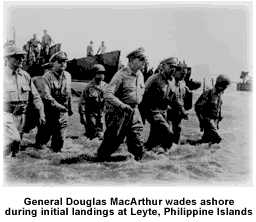 The capture of Wakde on the northeastern coast of New Guinea in May 1944 was followed by the seizure of Biak and Noemfoor. During the summer, a Japanese army attempting to break out from Wewak in Australian New Guinea was chastened. The invasion of Morotai in September placed American forces within 300 miles of Mindanao.
Marshall Islands
Near the close of 1943, a thrust at the Gilbert Islands from the Central Pacific, in which Tarawa, Makin, and Apamama were seized, paved the way for the assault on the Marshalls on 31 January 1944. American forces gained control of Kwajalein, Majuro, and Eniwetok, and their fleet and air arms moved forward.
At the same time, American carriers attacked Truk heavily, and that formidable enemy naval base in the Carolines was thenceforth immobilized. Saipan, Tinian, and Guam in the Marianas fell to American arms in summer 1944. The capture of the Marianas, and later Iwo Jima, provided fixed bases for B-29 Superfortress air attacks against Japan and surrounding islands.
With the first Battle of the Philippine Sea, the U.S. Navy administered a crushing defeat of the Japanese fleet that tried to interfere with the American push westward. In September and October, the Americans occupied Ulithi in the western Carolines for use as an anchorage and advanced fleet base, and took Angaur and Peleliu in the Palau Islands, situated close to the Philippines.
Aleutian Islands
Fighting in the Aleutians was known as the "Thousand-Mile War," the approximate distance between American bases on the Alaska coast, Dutch Harbor, and the westernmost Aleutian Islands. Attu and Kiska became a U.S. military priority because of a 57-mile gap that the Japanese feared the United States would use to attack their homeland — so the Japanese attacked first. Furthermore, the islands had important military value for the enemy because, if successfully held, they would more easily managed to take territory farther down the coast.
A Canadian and American force of 100,000 troops was deployed to push the Japanese from America's northwestern-most territory. In May 1943, after nearly two weeks of bloodshed under frostbitten climatic conditions, across some of the globe's most forbidding terrain, the 2,000 Attu-based Japanese were uprooted by the American Seventh Infantry Division.
Iwo Jima and Okinawa
Iwo Jima
The volcanic island of Iwo Jima was a crucial location for the island-hopping campaign to succeed. The island's proximity would make it possible for B-29 raids — halfway from Marianas Island to mainland Japan. Three airstrips, which the Japanese had been using for their Kamikaze** attacks, also made Iwo Jima a primary target. With the island captured, the Kamikazes would have to operate from Okinawa or Kyushu.
The capture of Wakde on the northeastern coast of New Guinea in May 1944 was followed by the seizure of Biak and Noemfoor. During the summer, a Japanese army attempting to break out from Wewak in Australian New Guinea was chastened. The invasion of Morotai in September placed American forces within 300 miles of Mindanao.
Marshall Islands
Near the close of 1943, a thrust at the Gilbert Islands from the Central Pacific, in which Tarawa, Makin, and Apamama were seized, paved the way for the assault on the Marshalls on 31 January 1944. American forces gained control of Kwajalein, Majuro, and Eniwetok, and their fleet and air arms moved forward.
At the same time, American carriers attacked Truk heavily, and that formidable enemy naval base in the Carolines was thenceforth immobilized. Saipan, Tinian, and Guam in the Marianas fell to American arms in summer 1944. The capture of the Marianas, and later Iwo Jima, provided fixed bases for B-29 Superfortress air attacks against Japan and surrounding islands.
With the first Battle of the Philippine Sea, the U.S. Navy administered a crushing defeat of the Japanese fleet that tried to interfere with the American push westward. In September and October, the Americans occupied Ulithi in the western Carolines for use as an anchorage and advanced fleet base, and took Angaur and Peleliu in the Palau Islands, situated close to the Philippines.
Aleutian Islands
Fighting in the Aleutians was known as the "Thousand-Mile War," the approximate distance between American bases on the Alaska coast, Dutch Harbor, and the westernmost Aleutian Islands. Attu and Kiska became a U.S. military priority because of a 57-mile gap that the Japanese feared the United States would use to attack their homeland — so the Japanese attacked first. Furthermore, the islands had important military value for the enemy because, if successfully held, they would more easily managed to take territory farther down the coast.
A Canadian and American force of 100,000 troops was deployed to push the Japanese from America's northwestern-most territory. In May 1943, after nearly two weeks of bloodshed under frostbitten climatic conditions, across some of the globe's most forbidding terrain, the 2,000 Attu-based Japanese were uprooted by the American Seventh Infantry Division.
Iwo Jima and Okinawa
Iwo Jima
The volcanic island of Iwo Jima was a crucial location for the island-hopping campaign to succeed. The island's proximity would make it possible for B-29 raids — halfway from Marianas Island to mainland Japan. Three airstrips, which the Japanese had been using for their Kamikaze** attacks, also made Iwo Jima a primary target. With the island captured, the Kamikazes would have to operate from Okinawa or Kyushu.
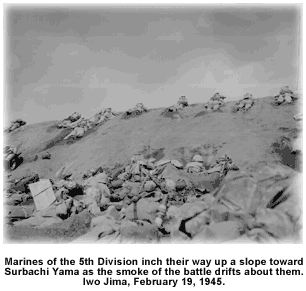 On February 19th, 1945, the U.S. Marine Corps' legendary Third, Fourth and Fifth divisions landed on Iwo Jima at 8:59 a.m. That came after 10 weeks of relentless bombing from carrier-based planes and medium bombers. The preliminary bombardment was the heaviest up to that point in the war. A total of 70,000 U.S. Marines charged the sandy beaches of Iwo Jima, against an opposing force of 27,000 Japanese.
The beaches were eerily quiet as the Higgins boats landed ashore and the marines began to offload. The minimal resistance, however, proved to be only a bluff to draw the exposed marines onto the beaches. It was then that 27,000 determined Japanese defenders, led by General Tadamichi Kuribayashi, opened up from a vast underground network of caves and tunnels. The relentless pre-invasion bombardment from naval and air forces had done little damage. While literally inching their way across the island, the marines were able to secure Iwo Jima after 36 days of brutal combat.
On February 19th, 1945, the U.S. Marine Corps' legendary Third, Fourth and Fifth divisions landed on Iwo Jima at 8:59 a.m. That came after 10 weeks of relentless bombing from carrier-based planes and medium bombers. The preliminary bombardment was the heaviest up to that point in the war. A total of 70,000 U.S. Marines charged the sandy beaches of Iwo Jima, against an opposing force of 27,000 Japanese.
The beaches were eerily quiet as the Higgins boats landed ashore and the marines began to offload. The minimal resistance, however, proved to be only a bluff to draw the exposed marines onto the beaches. It was then that 27,000 determined Japanese defenders, led by General Tadamichi Kuribayashi, opened up from a vast underground network of caves and tunnels. The relentless pre-invasion bombardment from naval and air forces had done little damage. While literally inching their way across the island, the marines were able to secure Iwo Jima after 36 days of brutal combat.
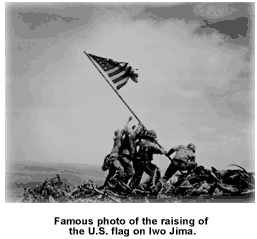 But victory came at a heavy price. At the battle's conclusion, 6,281 Americans and more than 20,000 Japanese were killed. Twenty-two marines and five sailors received the Congressional Medal of Honor for their actions on Iwo Jima — the most bestowed for any campaign. Admiral Nimitz remarked, "Among the Americans who served on Iwo Island, uncommon valor was a common virtue."
Okinawa
Code-named Operation ICEBURG, the invasion of Okinawa began on April 1st, 1945, when 60,000 troops (two marine and two army divisions) landed with little opposition.
The day began and ended with the heaviest concentration of naval gunfire ever used to support an amphibious landing. Strategically, positions off the invasion beaches were occupied by 10 older American battleships, including several Pearl Harbor survivors — the USS Tennessee, Maryland, and West Virginia; as well as nine cruisers, 23 destroyers and destroyer escorts, and 117 rocket gunboats. Together they fired 3,800 tons of shells at Okinawa during the first 24 hours.
The initial charge by U.S. troops was met by little opposition. However, the 100,000-plus Japanese who were dug into caves and tunnels on the high ground away from the beaches in an attempt to withstand the Allies' superior sea and air power.
But victory came at a heavy price. At the battle's conclusion, 6,281 Americans and more than 20,000 Japanese were killed. Twenty-two marines and five sailors received the Congressional Medal of Honor for their actions on Iwo Jima — the most bestowed for any campaign. Admiral Nimitz remarked, "Among the Americans who served on Iwo Island, uncommon valor was a common virtue."
Okinawa
Code-named Operation ICEBURG, the invasion of Okinawa began on April 1st, 1945, when 60,000 troops (two marine and two army divisions) landed with little opposition.
The day began and ended with the heaviest concentration of naval gunfire ever used to support an amphibious landing. Strategically, positions off the invasion beaches were occupied by 10 older American battleships, including several Pearl Harbor survivors — the USS Tennessee, Maryland, and West Virginia; as well as nine cruisers, 23 destroyers and destroyer escorts, and 117 rocket gunboats. Together they fired 3,800 tons of shells at Okinawa during the first 24 hours.
The initial charge by U.S. troops was met by little opposition. However, the 100,000-plus Japanese who were dug into caves and tunnels on the high ground away from the beaches in an attempt to withstand the Allies' superior sea and air power.
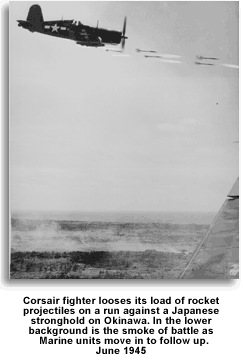 The battle proceeded in four phases: One, the advance to the eastern coast — April first through the fourth; Two, the clearing of the northern part of the island — April fifth through the 18th; Three, the occupation of the outlying islands — April 10th through June 26; and Four, the main battle against the dug-in elements of the 32nd Army — April sixth through the 21st of June.
Although the first three phases encountered only mild opposition, the final phase proved extremely difficult because the Japanese were deep underground and naval gunfire support was ineffective.
The battle of Okinawa proved to be the bloodiest battle of the Pacific War. Thirty-four allied ships and other craft of all types were sunk, mostly by Kamikazes, and 368 ships and craft were damaged. The fleet lost 763 aircraft. The total American casualties in the operation numbered more than 12,000 killed (including nearly 5,000 navy and almost 8,000 marine and army) and 36,000 wounded.
A-bomb
On July 2, 1945, while the Sixth Marine Division rested, trained, and prepared for the expected invasion of mainland Japan, the first atomic bomb was tested in New Mexico. An alternative to invasion was now a definite possibility. The morning of August 6, 1945, an atomic bomb exploded over Hiroshima. Three days later, Nagasaki suffered a similar fate. No mainland invasion would take place; the fighting was over.
The battle proceeded in four phases: One, the advance to the eastern coast — April first through the fourth; Two, the clearing of the northern part of the island — April fifth through the 18th; Three, the occupation of the outlying islands — April 10th through June 26; and Four, the main battle against the dug-in elements of the 32nd Army — April sixth through the 21st of June.
Although the first three phases encountered only mild opposition, the final phase proved extremely difficult because the Japanese were deep underground and naval gunfire support was ineffective.
The battle of Okinawa proved to be the bloodiest battle of the Pacific War. Thirty-four allied ships and other craft of all types were sunk, mostly by Kamikazes, and 368 ships and craft were damaged. The fleet lost 763 aircraft. The total American casualties in the operation numbered more than 12,000 killed (including nearly 5,000 navy and almost 8,000 marine and army) and 36,000 wounded.
A-bomb
On July 2, 1945, while the Sixth Marine Division rested, trained, and prepared for the expected invasion of mainland Japan, the first atomic bomb was tested in New Mexico. An alternative to invasion was now a definite possibility. The morning of August 6, 1945, an atomic bomb exploded over Hiroshima. Three days later, Nagasaki suffered a similar fate. No mainland invasion would take place; the fighting was over.